





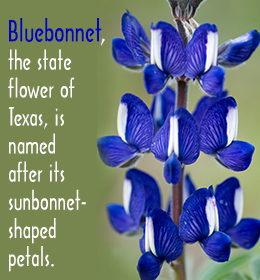 "The bluebonnet is to Texas what the shamrock is to Ireland, the cherry blossom to Japan, the lily to France, the rose to England and the tulip to Holland."
"The bluebonnet is to Texas what the shamrock is to Ireland, the cherry blossom to Japan, the lily to France, the rose to England and the tulip to Holland."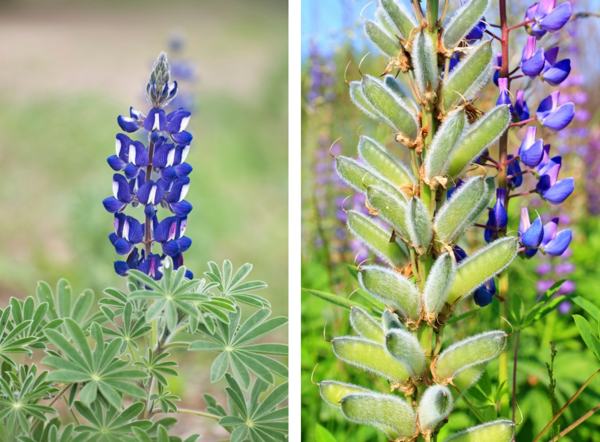 The flower spike, leaves, and seedpods of the bluebonnet plant.The plant belongs to the genus Lupinusin the legume family Fabaceae. It has palmately compound, alternate leaves; and the florets are arranged on long spikes. The much-loved species called Lupinus texensis has white tips. While Lupinus havardii has long flower spikes, Lupinus concinnus is an inconspicuous plant with short flower spikes that produce florets that are whitish-pink or lavender. Lupinus plattensis can grow to a height of around two feet. Bluebonnet flowers have a mild fragrance and the blooms are mostly found in shades of blue. You may also come across lupines with red, white, and pink blooms. Nowadays, numerous cultivars with differently colored flowers are also seen. Bluebonnet - The Official State Flower of Texas
The flower spike, leaves, and seedpods of the bluebonnet plant.The plant belongs to the genus Lupinusin the legume family Fabaceae. It has palmately compound, alternate leaves; and the florets are arranged on long spikes. The much-loved species called Lupinus texensis has white tips. While Lupinus havardii has long flower spikes, Lupinus concinnus is an inconspicuous plant with short flower spikes that produce florets that are whitish-pink or lavender. Lupinus plattensis can grow to a height of around two feet. Bluebonnet flowers have a mild fragrance and the blooms are mostly found in shades of blue. You may also come across lupines with red, white, and pink blooms. Nowadays, numerous cultivars with differently colored flowers are also seen. Bluebonnet - The Official State Flower of Texas The popular Lupinus texensis has racemes with white tips.The Texas legislature adopted bluebonnet as the official state flower during the year 1901. Though the species Lupinus subcarnosus was selected as the state symbol, the showier Lupinus texensis was preferred by many. The legislators were not aware about the different bluebonnet species. However, people demanded the status of official state flower for Lupinus texensis. In 1971, lawmakers amended legislation to include Lupinus texensis and other similar species that could be found in Texas, as the state flower of Texas. Five species of bluebonnets are found in Texas. Apart from Lupinus texensis and Lupinus subcarnosus, Lupinus havardii, Lupinus concinnus, and Lupinus plattensis are also found in the state. However, Lupinus texensis and Lupinus subcarnosus are said to be natives to the state.Bluebonnets Decorate Texas Highways
The popular Lupinus texensis has racemes with white tips.The Texas legislature adopted bluebonnet as the official state flower during the year 1901. Though the species Lupinus subcarnosus was selected as the state symbol, the showier Lupinus texensis was preferred by many. The legislators were not aware about the different bluebonnet species. However, people demanded the status of official state flower for Lupinus texensis. In 1971, lawmakers amended legislation to include Lupinus texensis and other similar species that could be found in Texas, as the state flower of Texas. Five species of bluebonnets are found in Texas. Apart from Lupinus texensis and Lupinus subcarnosus, Lupinus havardii, Lupinus concinnus, and Lupinus plattensis are also found in the state. However, Lupinus texensis and Lupinus subcarnosus are said to be natives to the state.Bluebonnets Decorate Texas Highways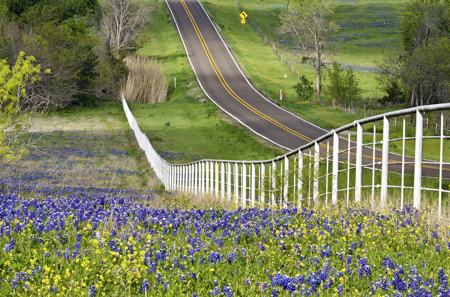 Bluebonnets growing on the roadsideThe Texas Highway Department maintains and preserves wildflowers, especially bluebonnets, that grow on roadsides. These measures were started during 1930s, when the department hired a landscape artist for the first time. The main purpose was to encourage growth of wildflowers along the highways. The department introduced new laws to delay mowing till the blooms wither and the foliage of the plants turns brown. Now, motorists and visitors can enjoy the vast fields of bluebonnets and other wildflowers that grow near highways. The department also maintains a wildflower hotline.Texas has an Official State Flower SongThe official flower of Texas has an official state flower song. The song 'Bluebonnets' written by Julia D. Booth and Lora C. Crockett was adopted by the Texas Legislature in 1933.When the pastures are green in the springtime
Bluebonnets growing on the roadsideThe Texas Highway Department maintains and preserves wildflowers, especially bluebonnets, that grow on roadsides. These measures were started during 1930s, when the department hired a landscape artist for the first time. The main purpose was to encourage growth of wildflowers along the highways. The department introduced new laws to delay mowing till the blooms wither and the foliage of the plants turns brown. Now, motorists and visitors can enjoy the vast fields of bluebonnets and other wildflowers that grow near highways. The department also maintains a wildflower hotline.Texas has an Official State Flower SongThe official flower of Texas has an official state flower song. The song 'Bluebonnets' written by Julia D. Booth and Lora C. Crockett was adopted by the Texas Legislature in 1933.When the pastures are green in the springtime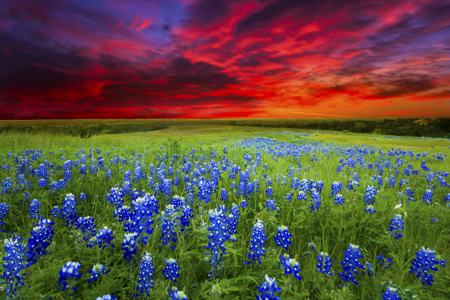 The bluebonnet trail near Sugar Ridge Road, Ennis.Apart from the state flower song, Texas has an official bluebonnet tartan. Ennis located in Ellis County is the official bluebonnet city. The official bluebonnet trail is also located in Ennis. There are many other bluebonnet trails in the state. Bluebonnet festival of Chappell Hill is one of the most famous festivals in Texas. It is also the official bluebonnet festival of the state.Bluebonnet Banner Spots and Pollination
The bluebonnet trail near Sugar Ridge Road, Ennis.Apart from the state flower song, Texas has an official bluebonnet tartan. Ennis located in Ellis County is the official bluebonnet city. The official bluebonnet trail is also located in Ennis. There are many other bluebonnet trails in the state. Bluebonnet festival of Chappell Hill is one of the most famous festivals in Texas. It is also the official bluebonnet festival of the state.Bluebonnet Banner Spots and Pollination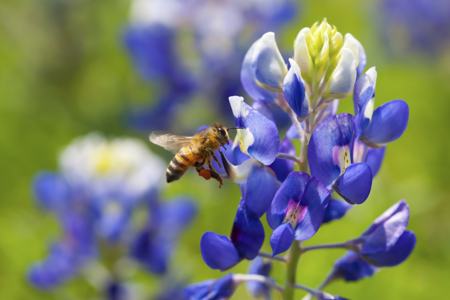 Bees are attracted by the white banner spots on bluebonnet petals.The bluebonnet florets have five petals each. Apart from the banner petal with a white banner spot that runs through its center, the floret has four more petals. Two are wing petals and the other two form the keel. The white banner spot is responsible for attracting pollinators like bees. The banner spots on the florets located at the lower parts of the spike are reddish-magenta in color. Florets located on the top parts of the raceme have white banner spots. The banner spots on new flowers with fresh and sticky pollen are white. The color fades to red as the flowers age, and the bees are no more attracted to such flowers. So, the change in color of the banner spots is like a signal to pollinators not to waste time on aged flowers.
Bees are attracted by the white banner spots on bluebonnet petals.The bluebonnet florets have five petals each. Apart from the banner petal with a white banner spot that runs through its center, the floret has four more petals. Two are wing petals and the other two form the keel. The white banner spot is responsible for attracting pollinators like bees. The banner spots on the florets located at the lower parts of the spike are reddish-magenta in color. Florets located on the top parts of the raceme have white banner spots. The banner spots on new flowers with fresh and sticky pollen are white. The color fades to red as the flowers age, and the bees are no more attracted to such flowers. So, the change in color of the banner spots is like a signal to pollinators not to waste time on aged flowers.Copyright © www.100flowers.win Botanic Garden All Rights Reserved